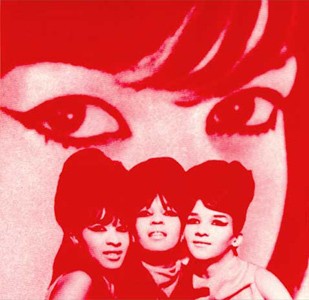Born to Be Together: The Ronettes embodied the submissive quality that characterized much of the girl-group sound.
Girl Power
Box set sets record straight on the fairer sex
By Greg Cahill
It’s the mother of all girl-group collections. The four-CD box set One Kiss Can Lead to Another (Rhino) gathers 120 rare tracks that sweep away the stigma of frivolity frequently attached to the female singing groups that prowled the pop charts in the early to mid ’60s.
The Shangri-Las, the Ronettes, the Crystals, all were big stars–what red-blooded heterosexual teen male didn’t lust after Ronettes’ lead singer Veronica “Ronnie” Bennett, clad in Chinese-print satin capris, her beehive hairdo piled high above mascara-laden bedroom eyes? But for all the bad-girl posturing, the Ronettes also embodied the submissive quality that characterized much of the girl groups’ more light-weight pop. Remember 1969’s “You Came, You Saw, You Conquered”?
You have to dig deep in the record store shelves to find a girl group that kept pace with its male counterparts, much less one that served up cutting-edge sounds, though the producer of Pebbles, Vol. 1 did just that in 1989 when he included the proto-punk of the Belles “Melvin” and Kim and Grim’s wonderfully soulful “You Don’t Love Me” on that acclaimed garage-rock anthology series.
But for the most part, few recognized that these young women ever made a significant contribution, and girl groups were relegated to second-class status as ear candy by rock critics and fans alike–until now.
One Kiss, packaged in a miniature hat box, sets the record straight. Stylistically, this material runs the gamut from country to R&B, garage rock to proto-psychedelia. The old standards–“The Leader of the Pack,” “Going to the Chapel”–are conspicuously absent, making way for such obscure gems as “Nightmare,” the Whyte Boots tale of romantic revenge; the Lovelites’ lament of unwanted pregnancy, “How Can I Tell My Mom and Dad?”; or What Four’s “I’m Gonna Destroy that Boy,” which delights in the notion of using sex to get even.
In other words, these ain’t your mother’s girl groups.
Still, some of the faces are familiar: Lesley Gore, the Chiffons, the Shirelles, as well as such Brit chicks as Cilla Black, Lulu and Dusty Springfield. But even familiar acts are cast in unfamiliar light: for instance, Dolly Parton makes an appearance as a teen rocker, you’ll find Cher’s “Dream Baby” and a then-fledgling Carole King.
Over the past 40 years, this music has provided a wellspring for Herman’s Hermits (Earl Jean’s version of “I’m into Something Good” far outstrips that British Invasion act’s hit version), the Ramones, Bruce Springsteen, Blondie, the Smiths, the Magnetic Fields and scores of other rock bands.
And a whole generation of ’80s and ’90s girl groups–Bananarama, Apollonia, TLC, the Sugababes, et al–has followed in the footsteps of these classic girl groups.
It’s great to see that these artists are finally getting recognition. One Kiss shines a light on a woefully overlooked period of rock history.
From the December 21-27, 2005 issue of the North Bay Bohemian.
© 2005 Metro Publishing Inc.











